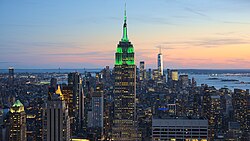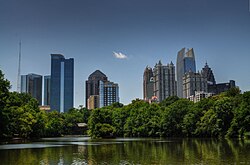


As of 2025, the United States has over 900 skyscrapers, defined as buildings taller than 492 feet (150 m), across at least 50 cities. [1] It has the second highest number of skyscrapers out of any country, after China. [2] For most of the 20th century, the largest skylines in the United States were also the largest in the world; currently, the country has five of the 60 cities with the most skyscrapers. The only two cities in the United States with more than 100 skyscrapers are New York City and Chicago. There are three cities with over 30 skyscrapers, that being Miami, Houston, and Los Angeles. Boston, Dallas, San Francisco, and Seattle each have between 20 and 30 skyscrapers.
Contents
- Cities with the most skyscrapers by height
- Measured in feet
- Measured in meters
- By metropolitan area
- Graphs
- See also
- Notes
- References
With the development of the earliest skyscrapers in the late 19th century, New York City and Chicago emerged as the two cities with the largest volume of high-rises in the country. They have continued to maintain that status until the present day. New York City is the city with the most skyscrapers, having over 320, more than twice as many as Chicago. It has the third-most skyscrapers in the world, after Hong Kong and Shenzhen. New York City makes up approximately one third of all buildings taller than 492 ft (150 m) in the United States. Chicago, with 137 skyscrapers, has the second-largest skyline in the country. Together, New York City and Chicago comprise about half of all skyscrapers in the country.
As more skyscrapers were built across the United States, the size of a city's skyline often reflected the city's relative importance. Large cities in the Northeast and the Midwest saw a construction boom during the Roaring Twenties, mainly from the mid-1920s to early 1930s. In addition to New York City and Chicago, high-rise construction hotspots in the early 20th century included Boston, Detroit, Philadelphia, and Pittsburgh, which were all in the ten largest cities by population during the 1920s. The Great Depression severely halted skyscraper development across much of the country from the 1930s to mid-1950s. When constructing new skyscrapers became feasible again, cities that underwent major construction booms included many in the Southern and Western United States, particularly Atlanta, Dallas, Houston, and Los Angeles. However, despite Los Angeles surpassing Chicago in population in 1982, [3] its skyline remains comfortably smaller than Chicago's today.
Construction slowed down again in the early 1990s, and resumed in major cities during the 2000s. The Great Recession dampened the construction of new skyscrapers for several years following its onset in 2008. New York City maintained its dominant position, entering an unprecedented skyscraper boom in the mid-2010s. Whereas skyscrapers were previously built mostly for office space in the 20th century, their development has shifted to being mainly for residential and mixed-use purposes. This has led to a dramatic growth in the number of tall buildings in a number of cities, most notably Austin, Nashville, and Miami. In particular, Miami's skyline grew rapidly from residential condominiums in the 2000s, and later from the 2010s onwards, becoming the city with the third-largest skyline in the United States. The 21st century has also seen the emergence of skylines in suburban cities, such as that of Bellevue, Jersey City, and Sunny Isles Beach, as well as multiple skyscraper clusters outside of Manhattan in New York City, including Downtown Brooklyn and Long Island City.



















































































